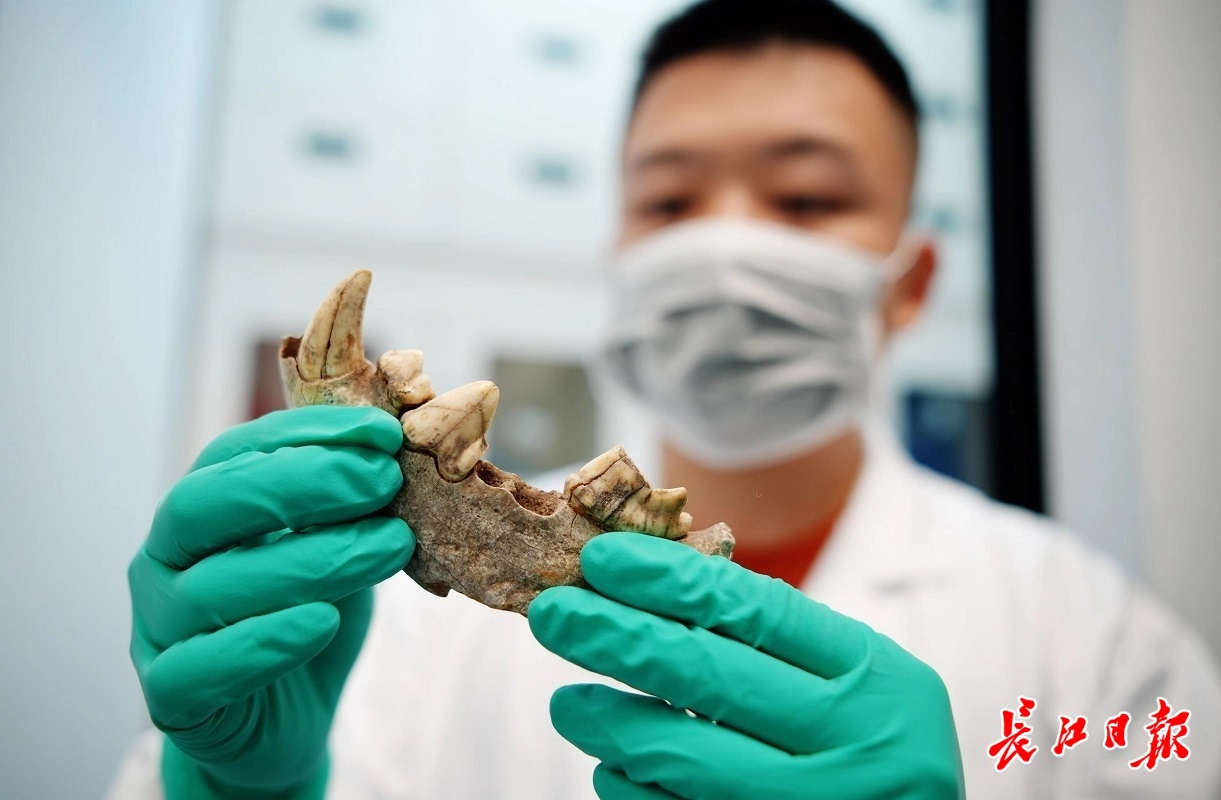The university college unexpectedly found the ancient tiger DNA from the baoli dog fossils
Author:Changjiang Daily Time:2022.08.13
Northeast China, 435,000 years ago, in addition to the ancestors of the Siberian tiger at that time, the king of forests at the time also had another genetic branch that was unknown -Da Anhu. In the long process of biological evolution, the number of Daanhu gradually decreased and even completely extinct.
Recently, researchers researchers at the National Key Laboratory of Biological Geology and Environmental Geology of China University of Geosciences accidentally discovered the new tiger branch of "Daan Tiger" from the Battle dog fossils. One department.
How did Da Anhu discover? What caused the ultimate extinction of Da Anhu? Can the current scientific research methods restore the shape of Da Anhu? Recently, a reporter from the Yangtze River Daily visited China University of Geosciences (Wuhan) Biological Geology and Environmental Geological State Key Laboratory. Researchers revealed the mysterious veil of Da Anhu.
Study the baoccol dog fossils, and accidentally discovered Da Anhu

Hu Jiaming showed the baoli dog fossils. Photo by the reporter He Xiaogang, a reporter from the Yangtze River Daily
Hu Jiaming is a doctoral student directed by Professor Lai Xulong, the ancient DNA group of China University of Geosciences (Wuhan). In recent years, he has been engaged in the research of spotted dogs under the guidance of the instructor. He told reporters that during ancient times, the cricket dogs were widely distributed in the Asia -Europe and Africa. About 20,000 years ago, the spotted dogs on the Asia -Europe continent were completely extinct, and the African bauls have continued to this day.
Professor Sheng Guilian of China University of Geosciences (Wuhan) has declared the National Natural Science Foundation of China. Through the analysis of the ancient genome analysis, the evolutionary history of Chinese renewal of Pautenia dogs is an animal. Hu Jiaming is a researcher at the project.

Jilin Tonghua Da'an Cave Ancient Tiger Fossil.
In 2003, the archeological team of Jilin University discovered a large number of paleomantic fossils in a cave in Da'an Town, Tonghua City, Jilin Province, including cattle, sheep, horses, rabbits, etc. There were also some spots of dog fossils. These fossils were formed in different historical periods.
Relying on the National Natural Science Foundation of China, relying on Professor Sheng Guilian, the ancient DNA research team of China University of Geosciences (Wuhan) has maintained a good cooperative relationship with Jilin University. In 2019, some members of the ancient DNA research team went to Jilin University to cut a small piece of skeleton fossil sample at the end of the jaw bone with a professional cutting tool, which was brought back to Wuhan for research.
"Cut this small piece of samples, we classified it to one of the samples of spotted dogs at that time." Hu Jiaming said, after returning, they extracted and analyzed the DNA remaining in the fossils, comparing the DNA sequence to the DNA sequence of the baolon dog DNA sequence Yes, it is found that the matching between the two is low, "this is definitely not a lotus dog." It is found that the DNA sequence of the mandible is the highest matching the tiger's DNA sequence.
"However, its DNA sequence is not exactly the same as several current tigers, which belongs to the new genetic branch that has never been discovered before." Hu Jiaming said that this is an unexpected discovery because the mandible fossil is in the mandibular fossils in the mandibular fossils. It was unearthed in Da'an Town, so the researchers named it "Da Anhu".
Not all fossils contain ancient DNA

China University of Geosciences (Wuhan) Biological Geology and Environmental Geological State Key Laboratory Ancient DNA clean room, researchers at work. Photo by the reporter He Xiaogang, a reporter from the Yangtze River Daily
In the key to enter the password, a "入" sound, the first door of the ancient DNA cleaning room of the China University of Geosciences (Wuhan) Biological Geology and Environmental Geology is opened. Entering the transition area of the laboratory, under the demonstration of Hu Jiaming, the reporter replaced the laboratory slippers, put on a conjoined experimental protection suit, put on a mask, PE gloves, and "fully armed" from head to toe.
After confirming that the reporter complied with the laboratory pollution norms, Hu Jiaming opened the second door and took the reporter to enter the extract room and the construction room in turn.

China University of Geosciences (Wuhan) Biological Geology and Environmental Geological State Key Laboratory Ancient DNA clean room, researchers at work. Photo by the reporter He Xiaogang, a reporter from the Yangtze River Daily
From the 2 grams of mandibular fossils brought back from Jilin University, the researchers carefully separated about 200 mg of trace samples from it to experiment. First grind it into powder, wash it with reagents, remove the bacteria and human DNA attached during the early burial and excavation process, degrade these potential exogenous pollution, and then add some chemical reagents to release the DNA inside the powder. In this way, the extraction is mainly from the endogenous DNA of the sample itself.
The researchers set out the extracted DNA to build a library, and then put it on the sequencer to feedback these DNA sequence information.
"After a long time erosion, the DNA of paleontology is fragmented, and the structure is no longer complete, just like a large and incomplete canvas." Professor Sheng Guilian, the person in charge of the project, said that the extraction of ancient DNA was to find these fragmented gene fragments to find these fragmented genes. After building the library, use the chemical reagents that can identify them to measure these DNA sequences.
"Not all fossils contain ancient DNAs." Professor Sheng Guilian said that DNA molecule degradation takes time. At present, the oldest and credible ancient DNA comes from the fierce elephant stored in the frozen soil 1.65 million years ago. It is not possible to retain the ancient DNA in the fossils with a short time. If it is an acidic soil, high temperature, and humid environment, the degradation speed of DNA molecules will be greatly accelerated.
The researchers compared the DNA sequence of this mandible to the DNA sequence of the mandibular dog and found that their matching degree is low. On the evolutionary tree, they belong to two different branches. It is found that the DNA sequence of the mandible is the highest in matching the DNA sequence of the tiger, but it is different from any existing tiger, which belongs to the previous unknown genetic branch. It takes more diversity to "draw" Da Anhu completely
The ancient DNA team of China University of Geosciences (Wuhan) is at work. Photo by the reporter He Xiaogang, a reporter from the Yangtze River Daily

From the perspective of evolving tree kinship, Da Anhu and Siberian Tiger can only be regarded as a "distant relative" 260,000 years ago. Professor Sheng Guilian introduced that the genetic branch represented by Da Anhu and the ancestors of the present tiger had parted ways about 260,000 years ago. The ancestors of the current tiger radiated in various places, forming different geographical subspecies, such as the Siberian tiger, the Sumatra tiger, the Bengali tiger (Indian tiger), the Java tiger, etc. Essence
During the carbon-14-year-old annual year, the period of Daanhu's survival was between 43,500 and 100,000 years. This period belongs to the end of the Fourth Crims of the Earth. The temperature of the Asia -Europe continent is low, especially in the northeast region of my country. The temperature is lower than it is now.
Scientific icon of the history of tiger evolution. a) Dynamic changes in the effective population of the maternity of the tiger; Source: China University of Geosciences (Wuhan)

"There are still very few human activities at that time, and it is unlikely to have a great impact on the survival of Da Anhu. Da Anhu is eventually extinct, which is likely to be affected by climate change." Sheng Guilian analyzed that as the temperature decreased, some plants could not adapt to it. The changes in the environment have caused a lot of herbivores with this food, which in turn caused Da Anhu at the top of the food chain to extinct.
Can Da Anhu's appearance be restored? Dr. Hu Jiaming told reporters that if he can find the complete skeleton of this tiger, he can basically restore its appearance. Restore the appearance of antiques based on bone science is the most scientific and reliable method.
"At present, Da Anhu's bones are still only a small piece. With this small piece of jaw bone, it cannot restore its body shape and appearance." Hu Jiaming said that molecular biological research makes the extinct tiger's branch sees the sun, but it is necessary In -depth analysis of the Da Anhu, to understand whether Da Anhu and the present tiger exist in genetic exchanges, you need to find more samples. By studying more genetic data, it will unveil the mystery of Da Anhu layer by layer.
This ancient DNA team has measured the first ancient panda whole genome
In ancient times 260,000 years ago, the tiger on the earth evolved into multiple spectrums including Da Anhu. Today, there is only one spectrum left on the earth. The mainland galloped upside down, and later, the sago dogs of the Asia -Europe continent were completely extinct; the fierce elephant in the elephant family, the sword -tooth tiger of the cat family, also disappeared in the long biological evolution ...
"If you do not do the research and analysis of the ancient genes, you will not know these secrets in the process of animal evolution, let alone reveal the reasons behind the fourth period of large mammals in the fourth period." Professor Sheng Guilian said.
According to the same research method, the Chinese University of Geosciences (Wuhan) Ancient DNA research team determined the first ancient giant panda whole genome in 2019, and discovered a genealogy of giant panda that is different from the existing giant panda.
According to Sheng Guilian, there are three different geographical groups in the current giant panda, namely Qinling population, Qishan species, 邛崃-Daxiangling-Xiaoshan-Liangshan species. The separation time of the new world giant panda and the existing giant panda ancestors discovered by the Chinese University of Geosciences and the existing giant panda ancestors were earlier than the formation of the three population groups of the giant panda, and there was a genetic exchanges with the ancestral population of the present giant panda. Some genes are also survived in the existing giant panda gene library.
Sheng Guilian introduced that the habitats of giant pandas in ancient times were widely distributed from south to north. Vietnam, Laos and other countries also had giant pandas. The current wild panda existed in the mountains of the Qinling Mountains. Ancient DNA can analyze how a large number of habitats have reduced the impact on the genetic diversity of giant pandas.
"The genetic diversity of species is a key factor that affects its evolutionary survival. With ancient times, research on paleontology genome can provide good evidence for the protection of biodiversity." Sheng Guilian, for example, said that the ancient pandas found in Yunnan, the ancient pandas found in Yunnan,, the ancient pandas found in Yunnan,, the ancient pandas discovered in Yunnan, the ancient panda found in Yunnan,, the ancient pandas found in Yunnan,, the ancient pandas found in Yunnan, Its genes have penetrated into the genes of the giant panda. It can be studied in which population it penetrates into, and it can be focused on the process of protecting the giant panda population. This process is very important. If you do not conduct research, there is no way to scientifically protect biodiversity, which will lead to the genetic component of this species becoming more and more single.
Sheng Guilian introduced that many biological resources on the planet have no potential value at present. Only by protecting wild animals and plant resources well, will it be possible to exert its value in the future. For example, the treatment of some diseases comes from some animal and plant resources at the beginning. If it is extinct if it is not proven, it will be a pity. In addition, people and animals and plants live together on this earth. Only by the protection of biodiversity can we realize the harmonious coexistence of man and nature. (Changjiang Daily reporter Wang Yang correspondent Chen Huawen)
[Edit: Deng La Xiu]
For more exciting content, please download the "Da Wuhan" client in the major application markets.
- END -
2022 Electricity Expo Hangzhou Qicu Black Technology is full

Photo by Wei Zhiyang, a reporter from Zhejiang News ClientOn August 3, e -commerce...
Cleaning, dialogue, and baby, the screen sweeper gets rid of the "artificial mental retardation" label

(The picture comes from the Internet, invading and deleting)Source | Intelligence ...